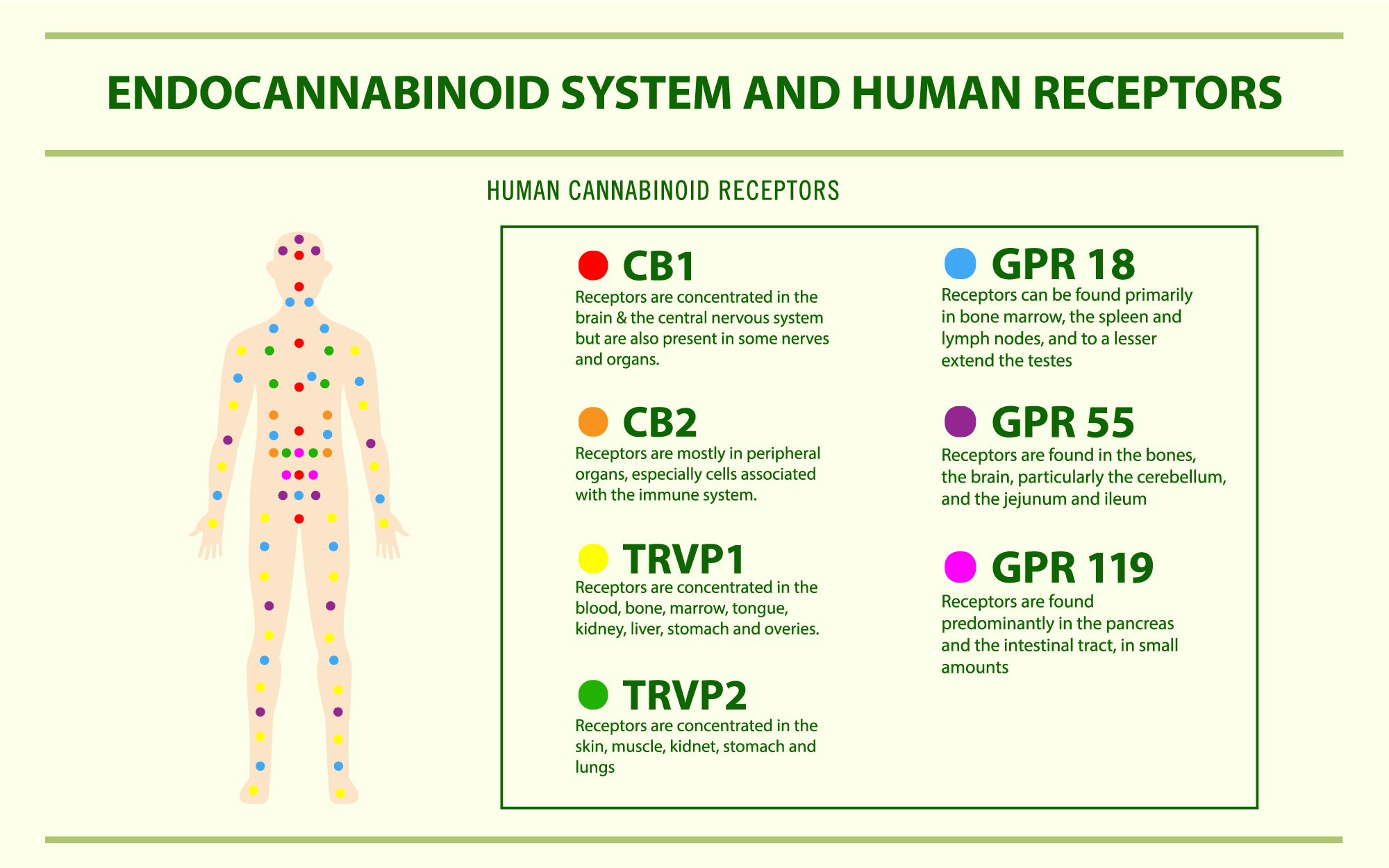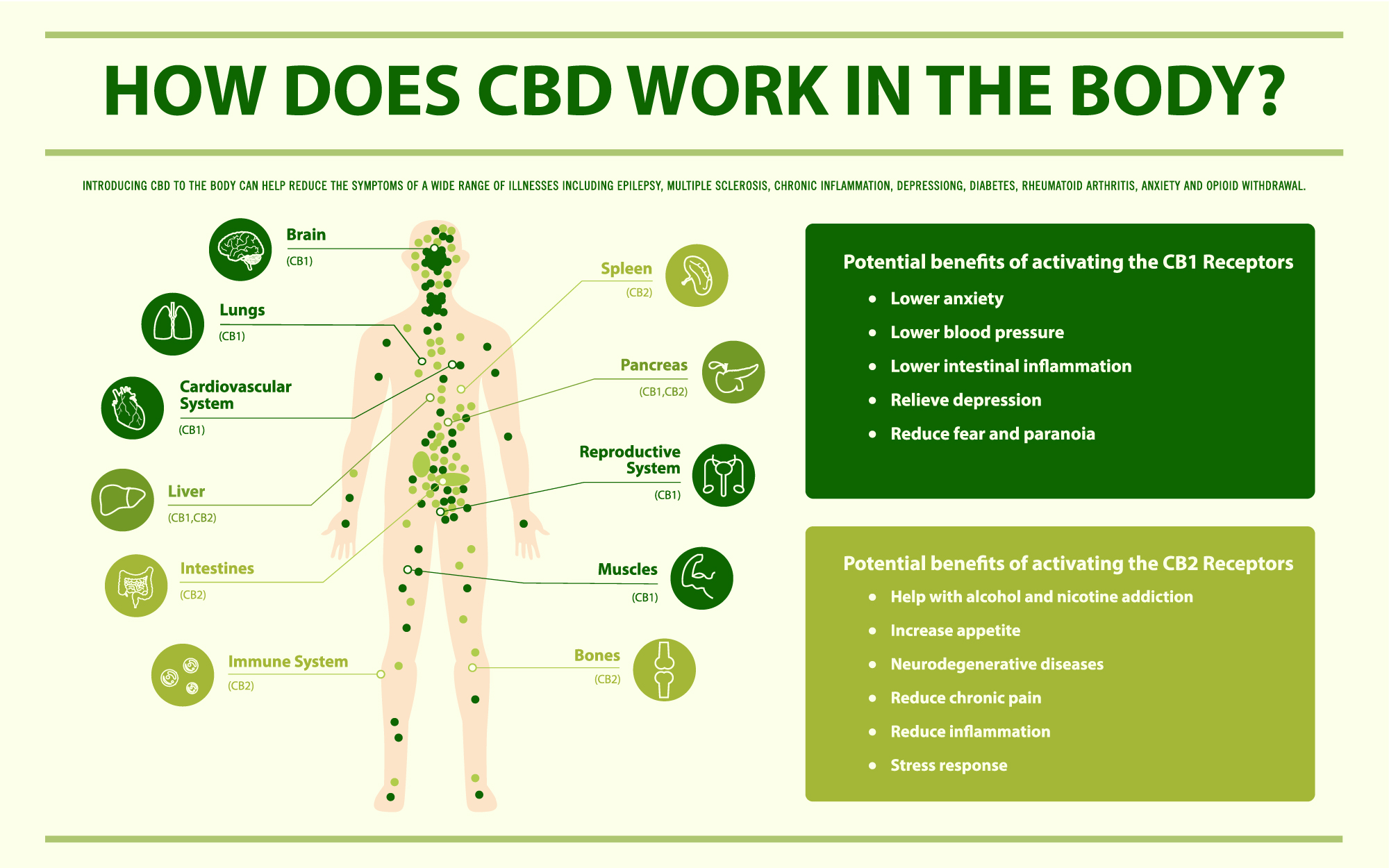
Rhodes Farm LLC has been a licensed CBD hemp grower since 2019. We start our crop indoors in the early spring and move the plants outdoors in late April. Our plants are 100% organic and pesticide-free.
If you’re unfamiliar with the Endocannabinoid system (ECS), you are definitely not alone. In the 1990’s scientists discovered endocannabinoids which are natural cannabis-like molecules produced by the human body to keep the body in homeostasis (equilibrium).
In English?
The endocannabinoid system is a natural collection of endocannabinoids (messenger molecules) and their associated molecules. These endocannabinoids affect your health and mental state by activating specialized message receivers, called cannabinoid receptors. The endocannabinoid system, with its complex actions in our immune system, nervous system, and all of the body’s organs, acts like a bridge between body and mind. In an article written by MindBodyGreen, according to Martin A. Lee, the director of Project CBD and the author of Smoke Signals, “The endocannabinoid system involves regulating most physiological processes that have been studied: immune function, pain perception, glucose metabolism, blood pressure, bone density, intestinal fortitude, sleep, mood, memory, neuroplasticity, and much more. It’s the reason cannabis and CBD are such versatile medicines that can help so many conditions.
So how exactly does the ECS work?
The ECS involves three core components: endocannabinoids, receptors, and enzymes.
Endocannabinoids
Endocannabinoids, also called endogenous cannabinoids, are molecules made by your body. They’re similar to cannabinoids, but they’re produced by your body. Experts have identified two key endocannabinoids so far; anandamide (AEA) and 2- arachidonoylglycerol (2-AG). Both of these play a role in keeping internal functions running smoothly. Your body amazingly produces them as needed.
Endocannabinoid Receptors
EDS receptors are found throughout your body. Endocannabinoids bind to these receptors in order to signal that the ECS needs to take action (producing endocannabinoids as needed).
The two main endocannabinoid receptors are CB1 receptors, which are found mostly in the central nervous system and CB2 receptors, which are found mostly in your peripheral nervous system, especially immune cells. Endocannabinoids can bind to either receptor. However, the resulting effects depend on where the receptor is located and which endocannabinoid it binds to. For example, endocannabinoids might target CB1 receptors in a spinal nerve to relieve pain, while others might bind to a CB2 receptor in your immune cells to signal that your body’s experiencing inflammation.
Enzymes
Enzymes are responsible for breaking down many things in the body, including endocannabinoids (once they’ve carried out their function). The two main enzymes responsible for this are the fatty acid amide hydrolase, which breaks down AEA and the monoacylglycerol acid lipase, which typically breaks down 2-AG. The ECS is an extremely complicated system that experts don’t fully understand yet. However, the research is ever-evolving and we know enough to understand the basics and how to use our ECS in conjunction with CBD and/or THC to our body’s benefit. Research shows that ECS’s main function is to keep the body in homeostasis.
Simply put
Simply put in this article: The eCB system is the homeostasis or balancing system for all of our other bodily systems and it is the largest receptor signaling system within the human body. Humans naturally produce endocannabinoids including Anand amide and 2-AG. These endocannabinoids fit like “keys” in the endocannabinoid receptor “lock,” and facilitate systematic balance within our body.

Humans have used cannabis for centuries, but only in the last 50 years or so has any scientific understanding emerged as to how cannabis works within the human body. While the discovery of the first plant cannabinoids took place in the 1940s, it was not until 1946 that THC produced by the cannabis plant was first characterized and synthesized by Gaoni and Mechoulam in Israel.
The discovery of THC in 1964 sparked the search for its mechanism of action. Initially, it was postulated that THC and other cannabinoids increased cell membrane permeability. Eventually, the permeability hypothesis was disproved, however, which led to the search for a protein receptor molecule in the body with which THC might be interacting. The first cannabinoid (CB) receptors in the body were not found until the late 1980s. These receptors turned out to comprise a new series of homeostatic regulatory mechanisms within the body, which was named the endocannabinoid system.
The endocannabinoid system is a very complex regulatory system, broad in its function, and found within all complex animals, from fish to humans. It regulates such diverse functions as memory, digestion, motor function, immune response and inflammation, appetite, pain, blood pressure, bone growth, and the protection of neural tissues, among others. The endocannabinoid system comprises three principal elements: endocannabinoid receptors; specialized molecules called endocannabinoids that interact with those receptors; and enzymes that either synthesize or metabolize the endocannabinoids.
The two primary subtypes of classical cannabinoid receptors in the endocannabinoid system are CB and CB. These receptors are distributed throughout the central nervous and immune systems, and within many other tissues, including the brain, gastrointestinal system, reproductive and urinary tracts, spleen, endocrine system, heart, and circulatory system. Many of the physiological effects of cannabis were first believed to be caused by the interaction of phytocannabinoids with the CB and CB receptors. In fact, because the THC family of cannabinoids are the only compounds that robustly activate the CB receptor, some have even suggested that its name be changed from CB to the THC receptor.
It is now known that cannabinoid interactions extend beyond the CB and CB receptors, however, and interact with other CB-type and related receptors and ion channels. These include the so-called orphan CB receptors GPR55, GPR18, and GPR119; the transient receptor potential vanilloid-type channel (TRPV1, associated with pain transmission and typically activated by temperatures over 109 /43, hot peppers or horseradish, and also known as the capsaicin receptor); and the peroxisome proliferator-activated nuclear receptors (PPAR-alpha and -gamma regulate important metabolic functions involving fatty acid storage, glucose metabolism, and development and progression of malignancies). Of these, other CB-type receptors, the orphan or candidate cannabinoid receptors are becoming increasingly important to the understanding of the endocannabinoid system.